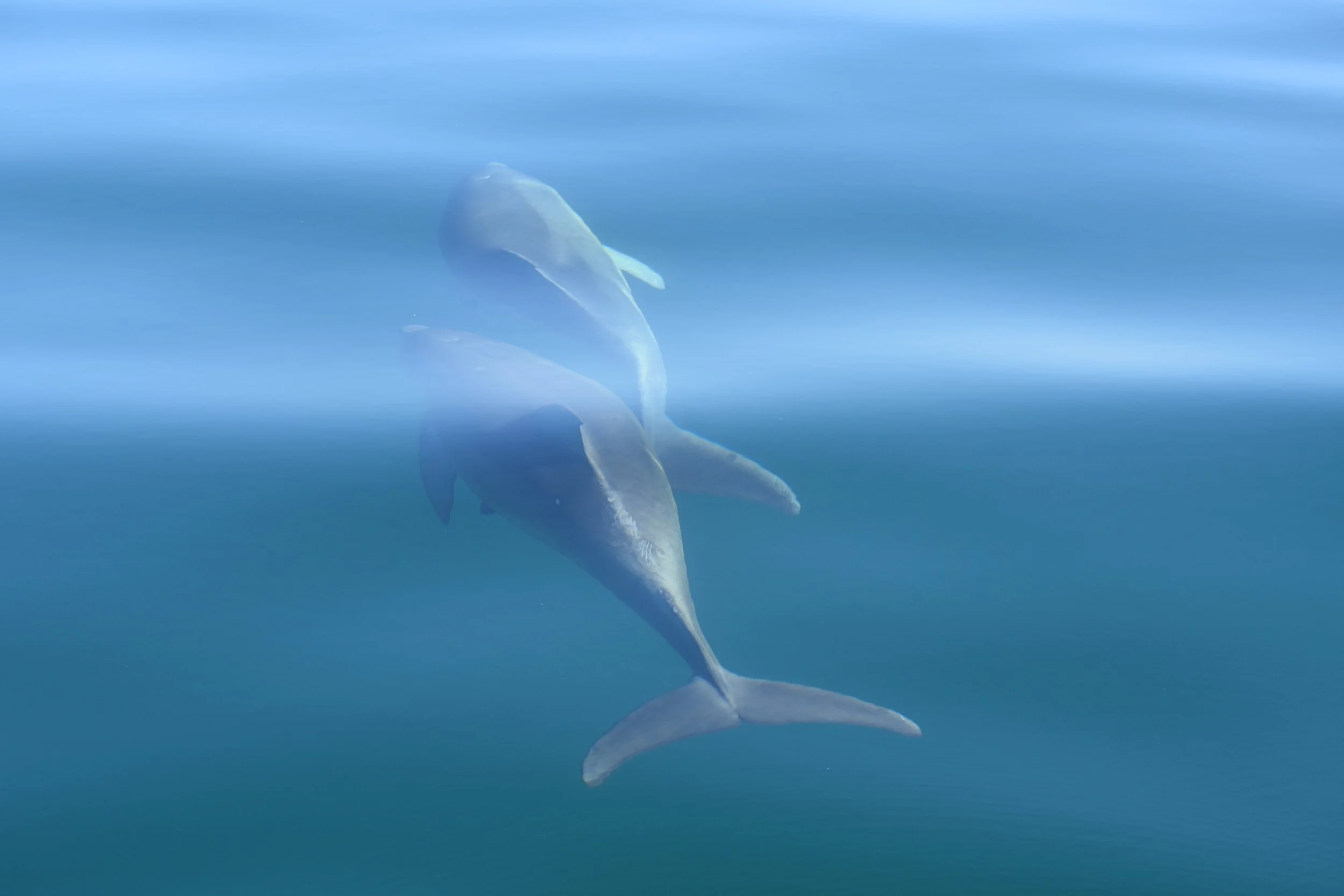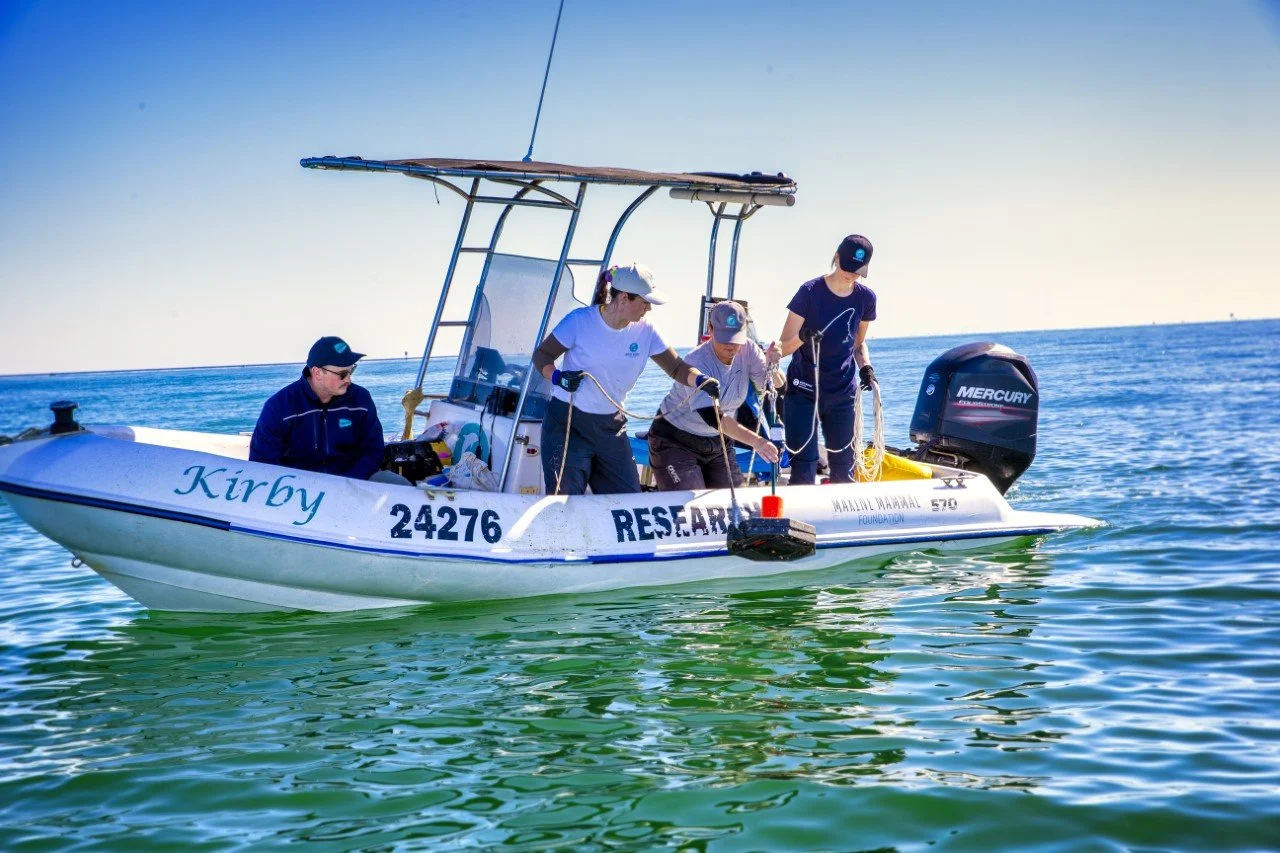
Burrunan Dolphin Acoustics Research
The Marine Mammal Foundation uses many different tools to assess the behaviour and distribution of the Burrunan dolphin. MMF’s acoustics research seeks to understand more about how our dolphins are communicating with each other and interacting with their environment through listening to and interpreting their numerous acoustic signals. This project will be coordinated by PhD candidate Amber Crittenden, supervised by MMF’s Director and Head of Research Dr. Kate Robb, and Curtin University’s Professor Christine Erbe.
The Marine Mammal Foundation is all about conducting applied research with real conservation outcomes.
Being a cryptic species, there is much we cannot learn about our Burrunan dolphins through observation alone. Studying the sounds our dolphins make through either vocalisation or behavioural action allows us to get a better understanding of how our dolphins are interacting with their environment when they are out of view.
The underwater environment is an incredibly noisy place, with many marine species using sound for some form of communication, navigation, or prey capture, as well as many non-biological sounds adding to the underwater orchestra, including the sound of wind and rain, or the sound of vessel engines or construction works.
Dolphins rely heavily on sound production to navigate, communicate, locate prey and in social behaviour, including group cohesion and recognition of familiar individuals. The frequency of sounds produced by a bottlenose dolphin ranges from 0.2 to 150 kHz, overlapping with the frequency range of sound produced by recreational boats (100 Hz and 10 kHz) (Hildebran 2009; Picciulin et al, 2010; Rako et al, 2013). Research has suggested that in noisy environments, dominated by recreational boating noise, dolphins may adjust call rates and shift their whistle frequencies to the range with lower noise interference in order to increase transmission efficiency and detectability of their acoustic signals (Rako-Gospic and Picciulin, 2016; Luis et al. 2014). Disturbances can hinder the core biological activities of dolphins and thus their health and condition, and in addition, can cause displacement from areas of high impact to areas of low impact. This disturbance and displacement can greatly affect the natural state of the dolphins (feeding, resting, social, calving rate etc).
While there have been numerous studies on the vocal repertoires of other dolphin species, we currently have little information on the frequency range or call rates of the Burrunan dolphin. This makes it difficult to identify their vocalisations within recordings where we don’t have visual confirmation of their presence, as well as assess if there are alterations in usual frequencies in response to boat disturbances.
The ways we study sound…
Passive acoustic monitoring
The Marine Mammal Foundation is incredibly proud of our recent partnership with GeelongPort in using PAM to study the critically endangered Burrunan dolphin population found in Corio Bay. MMF’s Matt spoke with Nine News about why this study is so important, and about how our findings will help us better protect and conserve this critically endangered species.
While we would love to be on the water across all of our study locations, it is not always possible, with elements like poor weather and number of daylight hours restricting the ability of our researchers to enter the field. This caused us to think a little outside the box to explore a new method of detecting dolphin presence and noise impact.
Passive acoustic monitoring (PAM) allows us to continuously monitor the underwater world and eavesdrop on our amazing marine mammals, including the endangered Burrunan dolphin. PAM is an effective, low-cost, non-invasive technique that efficiently collects long term data, enabling the detection of environmental change over time in the marine soundscape. MMF’s use of PAM involves deploying SoundTrap ST300 autonomous recorders, essentially an underwater microphone on a self-timer, in strategic locations throughout Port Phillip Bay and the Gippsland Lakes. This method enables marine soundscape data to be recorded on a 24-hour basis, bridging the gap in knowledge of dolphin activities irrespective of the presence of visual and/or boat-based surveys.
Having SoundTraps in place constantly recording will allow us to detect movement patterns of the Burrunan dolphins and other marine mammals. This will allow us to paint a more holistic picture of the usage of different habitat types and movement patterns of the two populations. The added beauty of these devices is they collect all ambient noise, also allowing us to assess ambient noise levels across our main study areas, noise emitted by small and large vessels, and natural biotic and abiotic habitat sounds.
During the COVID-19 pandemic, we have been using these SoundTraps to record for the very first time what our marine environments sound like without anthropogenic noise. Read more about that here!
Hand-held hydrophones
A great way to capture sound while listening in real time is with a hand-held hydrophone. These are small waterproof microphones that can be lowered over the side of a boat while connected to a recording device, allowing us to eavesdrop on the whistles, clicks and buzzes our dolphins are emitting while we are observing them.
Both the observational and acoustic behavioural data can then be correlated and used to understand which of the dolphin behaviours can be associated with each of the vocalisation types, or combinations of the types. For example, the rate of whistles emitted by a pod of dolphins has been linked to group size in wild bottlenose dolphins (Quick and Janik 2008), and an increasing click rate followed by a burst pulse sound (affectionately referred to as a “victory squeal”) has been associated with a successful feeding behaviour (Ridgway et al. 2015).
While our hand-held hydrophones allow us to listen to our dolphins when undertaking behavioural observations, these devices are somewhat limited in what we are able to capture. For the hand-held hydrophone to be in use the vessel engine must be switched off so that our dolphin vocalisations aren’t drowned out by the sound of the engine (a phenomenon termed “masking”) (Clark et al. 2009). This results in a large quantity of our acoustic recordings being taken while the dolphins are undertaking stationary behaviours (resting, feeding, etc.) and therefore very little understanding of the vocalisations the dolphins are making while undertaking mobile behaviours like travelling.
If you would like to help us get on the water and continue to conduct our research, consider a donation! As a small not-for-profit organisation, every little bit goes a long way.
Meet the Researcher!
Amber Crittenden is a PhD student at Curtin University working in collaboration with the Marine Mammal Foundation. She began as a volunteer at MMF in 2019, working with the Outreach and Education team, and assisting the Research team whenever the opportunity arose. She is now completing her PhD in marine bioacoustics and acoustic ecology. Through this project Amber hopes to bring the symphony of sound in our underwater environments to light, and to create innovative ways to study the cryptic behaviours of the Burrunan dolphin.
PUBLICATIONS
Rebecca Wellard; Kate Charlton-Robb; Christine Erbe; Bob Wong (2016) Whistle characteristics of newly defined species, the Burrunan dolphin (Tursiops australis), in coastal Victorian waters in Australia. The Journal of the Acoustical Society of America 140, 3416 (2016); doi: http://dx.doi.org/10.1121/1.4970980
Abstract:
A newly defined species, the Burrunan dolphin (Tursiops australis), was described in 2011 by Charlton-Robb et al., and is endemic to southern and south-eastern Australian coastal waters. This species’ distribution is characterized by small, isolated, and genetically distinct populations. With only two known populations in Victoria, the species is now listed as “Threatened” under the Victorian Flora and Fauna Guarantee Act. Describing and quantifying the vocal repertoire of a species is critical for subsequent analysis of signal functionality, geographic variation, social relevance, and identifying threats associated with anthropogenic noise. Here, we present the first quantitative analysis of whistle characteristics for the species, undertaken on these endemic Victorian populations. Vocalizations of T. australis were recorded during population based surveys in 2007 and 2014 across the Gippsland Lakes and Port Phillip Bay, Victoria. Acoustic parameters of whistles were measured including minimum frequency (fmin), maximum frequency (fmax), start frequency (sf), end frequency (ef), delta frequency (df= fmax-fmin), duration, number of extrema, number of inflection points, and number of steps. We review and compare T. australis whistle features to the two other bottlenose dolphins, T. truncatus and T. aduncus, to assess the similarity and/or differences between the sounds of the three species of bottlenose dolphins.





